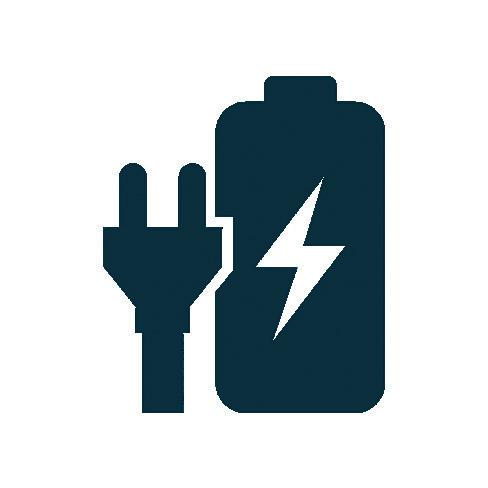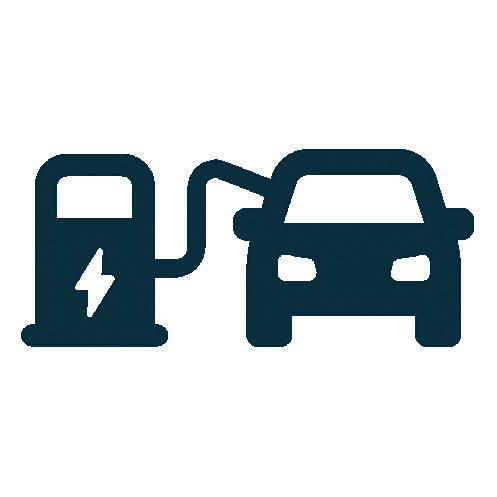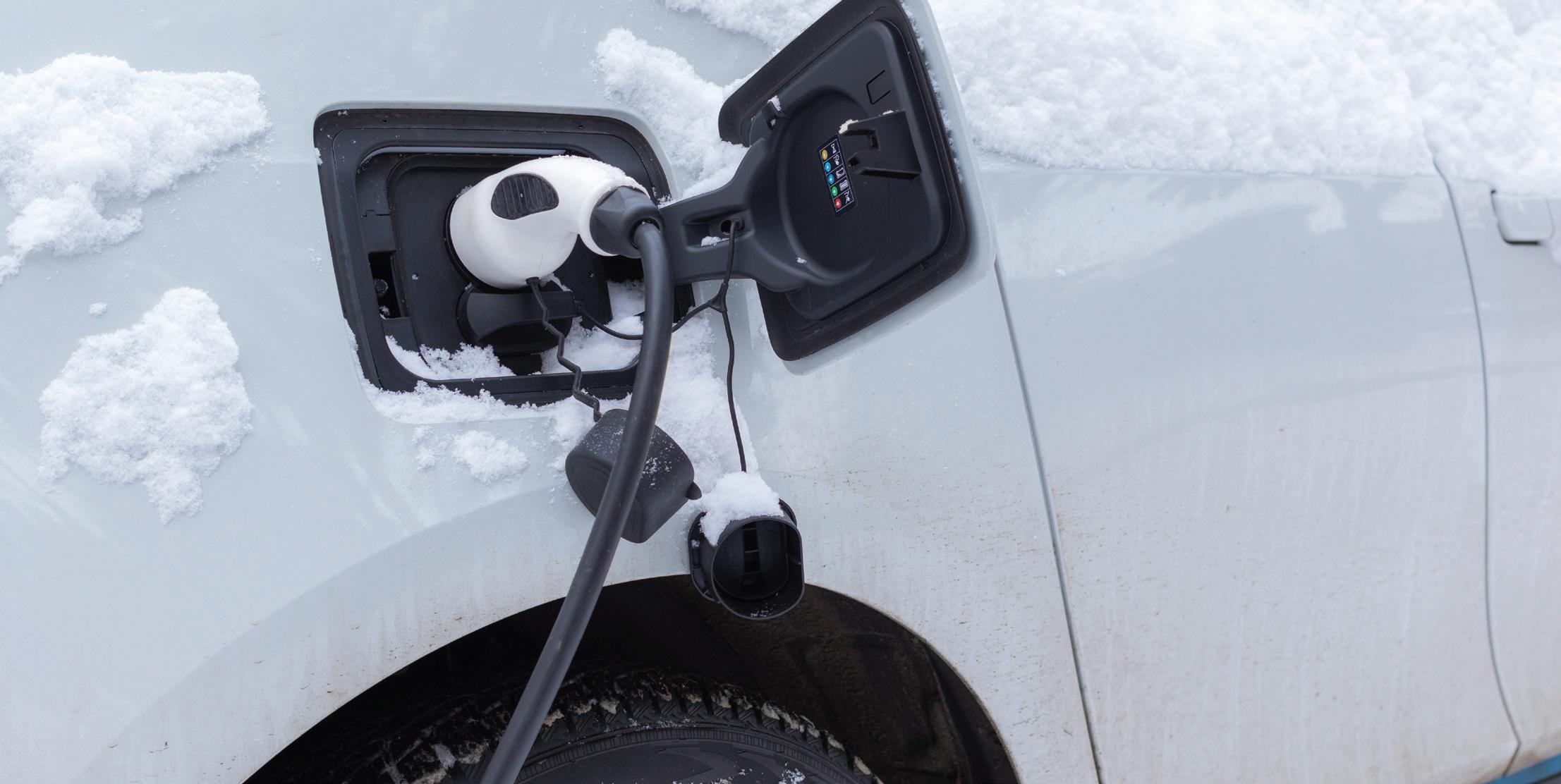Charging Etiquette
1. Only charge when you really need to.
If chargers are scarce and you can complete your trip without charging, leave the spot available for someone who really needs it.
2. Move your car when you’re done charging.
If you’re taking up a charging spot, don’t spend three hours window shopping. Come back after you’re adequately charged and free up the space for the next driver. Apps can help with this by notifying you of your charging status.
3. Check in.
If you use an app like PlugShare, check in and out to let other drivers know if the charger is available. See page 7 for a list of EV apps.
4. Leave reviews.
Did you pay a parking garage fee only to find that the chargers aren’t available on weekends? Leave a review on PlugShare or other apps to let other drivers know to look elsewhere.
5. Leave EV parking spaces for EVs.
Oftentimes chargers are located close to businesses, potentially taking up “prime parking spots” – that’s likely due to the proximity to the building’s electrical room. The power for the EV chargers comes from the building’s electrical service, so the closer the charger is to the building, the more cost-effective it is to install.
CassCountyElectric.com September 2021 | Highline Notes 5
INCENTIVE FOR EV CHARGERS INSTALLED ON OFF-PEAK: EV requirements to qualify for off-peak All-electric vehicles and plug-in hybrids qualify Level 2 charger, 240V
windows
AM June-September: Midnight-10 AM
may be subject to change, conditions, or restrictions.
incentive credit of $750
purchased.
incentive
in the form of an energy credit after a Cass
Electric technician has verified the account. OFF-PEAK RATE: LEVEL 2 CHARGER REIMBURSEMENT AT $50/kW ($750 MAX PER CHARGER) $**0.056 OFF-PEAK RATE ($5 MONTHLY METER CHARGE)
Nothing is worse than pulling up at a charging station when you’re running on proverbial fumes, only to find that all chargers are in use
– or worse, blocked by a non-electric vehicle. Do your part to make charging a reliable and smooth experience for EV drivers by following these etiquettes rules.
Charging
October-May: Noon-5 PM and 11 PM-7
*Please visit with our energy management team for details, terms, and conditions about specific offers and credits available. Marketing promotions/incentives
There is a maximum
depending on kW
To be eligible, the member must install the charger on Cass County Electric’s off-peak program. The
will be applied
County
In addition to the incentives offered from Cass County Electric, current federal consumer tax credits are available for EVs, ranging from $2,500 to $7,500 based on the size of the vehicle’s battery. Also, many insurance carriers offer discounted rates. Cass County Electric provides the load control device free of charge.
CCEC Program **Electric rate dependent on other off-peak loads on the account and the time of year
“The benefits of having the electric bus range from saving time and not having to go to a fuel station - instead we plug it in to the garage. The bus has no emissions or noise, making the students love the ride to school.”
- Brad Redmond
LEADING THE CHARGE
EV Bus
The Blue Bird electric school bus designated as e16 is entering its third year of picking up and dropping off West Fargo students. “It’s been an interesting journey for us,” said Brad Redmond, director of transportation at West Fargo Public Schools (WFPS).

On average, the electric bus loses 30% of its maximum range in cold weather. After experiencing the first winter, WFPS teamed up with Blue Bird to give the e16 bus two significant updates to help preserve range. The first update was installing an insulated pack that wraps around the batteries and coolant lines. The second was a software update to preheat the bus while it’s still plugged in. These updates allow the driver to heat the bus’ cabin before leaving the parking garage to start their route—meaning they won’t lose any miles on their daily range through heating the bus to temperature.
Operational & Maintenance
Per Mile (20’ & 21’ school year)
Diesel #1: $0.40
Diesel #2: $0.33
Electric (e16): $0.11
Savings per mile (avg.): $0.26
Total savings: $3,208.10
WFPS is a cold weather electric bus pioneer, paving a path toward more potential electric school buses. By educating students and providing firsthand experience of riding an electric bus, there is a chance these future drivers might think twice about purchasing a mainstream vehicle and instead opt for an electric one.
CCEC public chargers
In 2020, we partnered with West Acres Shopping Center, Hornbacher’s Gateway West, and the FM Convention and Visitors Bureau to bring three Level 3 fast chargers to the area. These chargers are the first of their kind on our system and some of the first in North Dakota. Based on sessions from October 2020 through August 2021, the average cost for charging is $13.35 for 28 kWh of energy and 46 minutes. Depending upon the vehicle, this is approximately 100 miles of range.
We installed our Level 3 DC fast chargers in easy-to-access locations for travelers close to the interstate. These chargers are close to restaurants, shopping, and more to provide EV drivers something to occupy time while waiting for a full charge.
According to Cass County Electric’s ChargePoint analytics, in the lifetime of our Level 3 public EV charging stations, we have avoided 4,092 kg of greenhouse gas emissions – that’s like planting 105 trees and letting them grow for 10 years! Together, let’s continue to lead the charge of electric technology.
Electric motorcycle
Cass County Electric, Fargo Police Department, and Fargo Parks District partnered to bring the first all-electric patrol motorcycle to the area.
The electric motorcycle has many advantages for both the public. Officer Marvig was the original assigned rider. He patrolled places where other officers rarely or never get to with their vehicles, which offers a safer trail atmosphere for parkgoers. “There is peace of mind knowing that the police are around even when things are good.”
The Fargo Police Department officially oversees the electric patrol bike and uses it for community events and some traffic stops. By utilizing the bike to patrol the parks and educate the community it creates a positive impact, offering a roadmap and proving how electric vehicle technology is a unique and reliable tool.
6 Highline Notes | September 2021 CassCountyElectric.com
FIND A STATION
With the increasing popularity of EVs, as well as clean energy goals of municipalities, businesses and some government agencies, the nation’s EV charging network is growing –and that’s only going to continue. In 2020 there were some 43,000 publicly accessible EV charging stations nationwide, according to the U.S. Department of Energy’s Alternative Fuels Data Center. You can put range anxiety to sleep knowing there are tools to locate your next charge.

Google Maps
If you already have Google Maps on your phone, you’re ahead of the game. In late 2018, Google announced it would support searches for EV charging stations on the Google Maps app. All you need to do is type “EV Charging Stations” or a related term into the search bar, and you’ll see a list of stations near you. Also included: the plug type, whether it’s free or paid, and how many chargers are available.
PlugShare
PlugShare is one of the more popular apps for EV drivers. It provides information about public charging stations around the world and allows users to post check-ins,
ratings and reviews. It also allows you to filter by your charger type and even provides a trip planner tool.
ChargeHub
ChargeHub is a communityaugmented charger finding app that allows you to see charge type, find out if a charger is available, add your own personal charger to the network to share the love, and even pay for charging using the app. The ChargeHub website offers discounts on EV products, savings calculators, a trip planner and lots of EV-related content.
Tesla
If you’re a Tesla owner, you’re really missing out if you’re not using the Tesla app. Not only does it link you up with Superchargers on your route, it also works as a veritable remote control for your car. It allows you to check charging progress and start or stop charging, heat or cool your car before getting into it, lock or unlock your car from afar, and more. Non-Tesla owner, the only reason to download this app is to stoke your Tesla envy.
Join these charging networks
One of the main complicating factors in EV charging on the road
is that many different companies own and operate their own charging stations, and many of those companies require you to be a member in order to use the station. Those memberships are often free, but you’ll want to sign up for them in advance and either get the membership card or download the company’s app. You’ll preload your credit card info so that when you get to the charging station, you can scan your card or the app and get charging.
There are also some free stations available – often at governmentowned facilities like libraries or recreation centers, or at grocery stores. But they tend to be popular, so you shouldn’t rely on them as your only option for on-the-go charging.
Here are some of the most popular charging networks. See which ones operate near you and decide which one you’d like to sign up for.
CassCountyElectric.com September 2021 | Highline Notes 7
1. ChargePoint 2. Blink 3. SemaConnect 4. EVgo 5. Greenlots 6. Tesla Supercharger
glossary
EV Terminology









L1 L2 L3
Level 1 charger: Level 2 charger:
Charges your EV using a standard household outlet up to 120v. Level 1 is the slowest method of charging and can take up to 24 hours or more to fully charge your EV.


Charges your EV at 240v using an installed outlet. Level 2 chargers are the recommended chargers for EV owners. Level 2 can charge 5x faster than Level 1, which equals up to 26 miles per hour of charging.

Level 3 charger:
Also known as a DC or fast charger, and the fastest method of charging for all EVs. It can fully charge an EV battery in about half an hour. Infrastructure is expensive, but is steadily improving in our area.
Tesla Supercharger: Off-peak charging: Range anxiety:
A super-fast charging system that can provide up to 250 kW directly to the car’s battery. These systems are only available to Teslas.
Charging your electric vehicle at certain lowest-cost off-peak hours. See page 5 for information.
Worry or stress that is caused due to the fear that an electric car will run out of battery power before the destination is reached.
DUE TO LOW DEALER STOCK, WE HAVE DECIDED TO POSTPONE OUR EV TAILGATE PARTY. STAY TUNED!
THE ROAD TO EV CHARGING
Imagine never going to the gas station again. If you’re a homeowner with an electric vehicle (EV), installing a Level 2 charger in your garage makes “refueling” a breeze. A Level 2 charger significantly cuts the time it takes to replenish the battery. To help our members charge faster, Cass County Electric Cooperative provides an incentive to help cover the cost of a charger when signing up for our off-peak program!
Determine your home’s eligibility. Confirm with Cass County Electric that your home is eligible for charger installation and incentives.
Get an electrical assessment of your home. Consult a licensed electrician to assess whether your electrical service has the capacity for a Level 2 charger. If you are building or remodeling, consider making your home EV ready by installing a dedicated 240-volt, 50-amp (minimum) circuit to serve a charger in the future.

Choose your charger. Aside from Tesla-model vehicles, EVs and plug-ins in the U.S. use the SAEstandard J1772 plug. Level 2 chargers range in price from less than $500 to more than $1,000. Cass County Electric provides a $50/kw ($750/max) rebate toward the purchase of a Level 2 charger when installed on our off-peak system.
Arrange for the electrical work.
Contact a licensed electrician. This professional can add a new panel, make any necessary service upgrades and install your new charging station. This is also the point in time when your electrician will sign out a ripple control device that will provide the off-peak functionality that allows Cass County Electric to signal to the charger when to charge, earning you the discounted electric rate.
Install the EV charging station. Most charging stations are suspended on a wall in a garage near where the EV will be parked. Consider the distance to the charging port on the car and the length of the cord you plan to use when determining the location.
Contact us to complete your application. After you complete the steps above, contact us at energy@kwh.com or 701-356-4400. A Cass County Electric technician must inspect the service for you to receive the off-peak rate.
CassCountyElectric.com September 2021 | Highline Notes 9
1|
2|
3| 4|
5|
6|
safety
Many novice electric vehicle (EV) owners and those interested in plug-in cars wonder what will happen if they charge their electric vehicle in wet or snowy conditions. Will I get shocked? Is it dangerous? Those are good questions to ask because usually electricity and water do not mix. Normally, standing on a wet surface and plugging something in is a bad idea.
However, using your EV charging equipment is usually safe to do in wet conditions. The Society of Automotive Engineers (SAE) designed and rigorously tested EV charging equipment to ensure safe charging in almost any weather conditions (we don’t advise it during a flood, for example).
The car’s electrical system is engineered to resist rain and water intrusion, as well as dust particles, all of which could damage it. Reputable charging equipment systems should be engineered with the same precautions. After all, if they weren’t, EV enthusiasts
could only charge their vehicles on a nice day – and we know North Dakota weather isn’t always pleasant.
That being said, there are some general charging station precautions to keep in mind. Safe Electricity and Cass County Electric point out these EV charging safety tips:

1. All components of a charging station should be in good working order. Look closely for signs of vandalism or disrepair.
2. Although it sounds obvious, never use an EV charger if it’s off its base or otherwise damaged, which could be caused by a natural disaster, major construction mishap, or other type of accident.
3. If you are considering having a Level 2 charging station installed at home, make sure it’s certified by a reputable and independent testing laboratory (or purchased from the car manufacturer) and professionally installed. (See page 8 for the different
charging levels) Level 1 charging requires a regular outlet. Level 2 equipment requires a 240v outlet.
4. Always follow manufacturer’s directions when charging your vehicle.
5. Place charging components up and out of reach when not in use.
6. If you have an at-home unit in a carport or exposed area, make sure the outlet is covered so that water does not get inside the outlet.
For more information about electrical safety, go to CassCountyElectric.com/ SafetyBlog.
If you have questions about an at-home Level 2 charging station and its energy use, contact us at 701-356-4400. Level 3 changing stations, which fully charge an EV in about an hour or less, are usually offered at public charging stations. See page 7 for where to find public charging stations.
CassCountyElectric.com September 2021 | Highline Notes 11
Will charging your electric vehicle leave you singin’ in the rain?
Electric Vehicles
ELECTRIC VEHICLE
CHARGING
The future of transportation is electric. Adding an electric vehicle (EV) to your garage can save you money, help you become more environmentally responsible and simply give you a better driving experience. Plus, charging at home is easy and inexpensive – and your utility will help you get started. Installing a Level 2 home charger is much like installing the wiring for a clothes dryer or other heavy appliance – it needs a 240-volt source. Most homeowners hire an electrician for this, and it can usually be done in a few hours. A Level 2 charger can refill a standard 60-kW EV battery in about 6-8 hours. That means you can plug in, go to sleep and have a fully charged car in the morning.
Your utility may offer rebates for the installation of home charging equipment (often $500-$1,000) on the off-peak program. That helps you take advantage of a super-low electric rate – less expensive than traveling on gas. In exchange for the lower rate of the offpeak program, charging is limited to certain hours, typically overnight.
BENEFITS
SAVINGS – At the standard electric rate, most electric vehicles can be fully recharged at home for about $7. For consumers who participate in the off-peak charging program, it costs about 65 cents to drive an electric vehicle the same distance that an average car can go on a gallon of gasoline.
changes, because no oil is used to run the engine.

LESS
vehicles
oil
They do not require air filters, spark plugs, timing belts or many other parts that need occasional replacement in a gasoline car. SMOOTH RIDE – EV motors are nearly silent and provide smooth (and incredibly fast) acceleration, as there are no shifting gears. With a heavy battery creating a low center of gravity, EVs handle curves and turns like a dream. NO EMISSIONS – EVs release no tailpipe emissions, creating cleaner air in your community. CHARGING OPTIONS Level 1 Level 2 Level 3 (DC Fast Charge) Cost to Charge Charging Speed Electric Requirements Standard electric rate Around 5 miles of range per hour (36 hours for depleted standard battery) Plugs into a standard 120-volt outlet Qualifies for reduced off-peak rate Around 25 miles of range per hour (6-8 hours for depleted standard battery) Uses a 240-volt charging station installed at home or in a public space For drivers, may be free or charge a usage fee Around 100 miles of range or more per hour (time dependent on battery depletion level) Requires utility involvement, usually only found in public along major corridors 10 / Electric Living
MAINTENANCE – Electric
do not require
ELECTRIC VEHICLE CHARGING
The DeFoes’ story
When Adam and Britani DeFoe moved their family from Nebraska to West Fargo, N.D., more than three years ago, they had a lot to figure out. Adam was starting a new physician interventional radiologist job at Essentia Health, their four kids would be experiencing a new community and they were building a new house from afar.
But one thing was easy to figure out. Adam had a Tesla Model 3 on preorder, and he wanted a way to charge it quickly at home.
“Our builder just asked me about it. He gave me the option of the off-peak meter for the charger, and he said, ‘You’ll save a lot.’ Right away I said yes – put that in!” Adam said with a laugh.
The DeFoes, Cass County Electric Cooperative members, have racked up the savings by charging their electric vehicle (EV) on the off-peak program, which offers them a reduced electric rate for charging the car during low-demand times of day – often overnight. Additionally, a charger rebate is offered to members who enroll in the off-peak program. Adam simply plugs into the 240-volt system when he gets home, and the car is programmed to begin the charging process at the set offpeak time. Even if the battery is nearly depleted, he has a full charge by the time he needs to leave for the hospital.
“Especially compared to paying for gasoline, charging the car is pennies. It takes very little electricity to make this car get to work and back,” Adam said. “You definitely see the cost savings in the long run. Electric vehicles are
great, especially if you are doing a lot of around-the-town commuting.”
Inexpensive “fuel ups” are just a small reason Adam loves his EV. He hasn’t had to bring the car in for maintenance the entire three years he’s had it (no oil, no belts, no problems), he likes that it is American made and environmentally friendly, and he can’t get enough of the high-tech features and app capabilities.
He’s most charged up about one detail in particular.
“They are super fun to drive. The acceleration…” he said with a pause. “You can’t beat it.”
The DeFoes have become fast advocates of EVs and are thrilled to see fast charging stations and Tesla Superchargers pop up in their neighborhood and towns around the region. Britani drives the EV whenever she has the chance, and the couple certainly envisions plug-in fandom continuing through their next generation.
“My oldest will be 11 soon, so I’m thinking it might be passed on to her, because the safety ratings on this thing are amazing,” Adam said.

“It takes very little electricity to make this car get to work and back. You definitely see the cost savings in the long run.”
Electric Living / 11
– Adam DeFoe


















